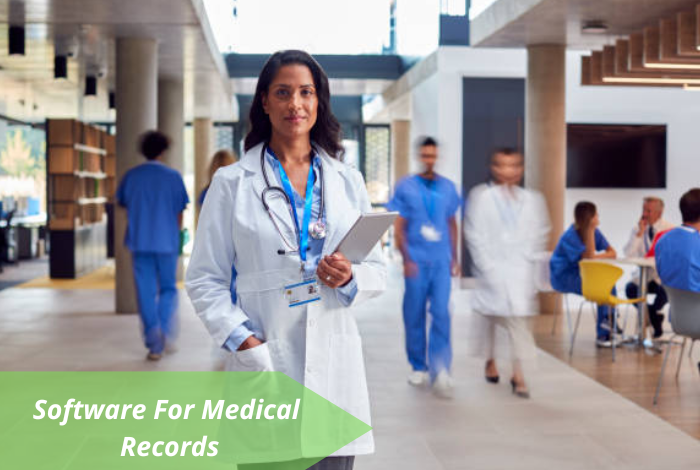Most Important Key Features of The Software For Medical Records

Utilizing Software For Medical Records is standard practice for healthcare facilities in the majority of developed nations. With the use of these records, hospitals may streamline a number of operations and improve their level of service, which ultimately helps the patients.
What is in medical record software, and why is it important?
Many general and treatment-specific facts about each patient that visits the medical facility are included in the software used to keep medical records. In it, you’ll find details like:
Names and numbers to call
Insurances
health conditions and remedies
X-rays
Test results
Vaccinations
Allergies
The healthcare sector would be much less productive if every patient’s statistics were manually recorded because it would take too long and be nearly impossible. Additionally, medical professionals are also people, thus mistakes could happen if notes were taken by hand. The sad possibility that some information is lost could result in errors!
This is where the digital medical records component enters the picture because it eliminates all these concerns by keeping track of everything in a digital manner. Let’s examine the main elements of the software used to maintain medical records.
Key components of software for medical records:
Gathering of important information
One of the main purposes of medical record software is to collect data and keep it secure. The kinds of information that the software gathers are as follows:
Patient demographic information, including age, sex, country, etc.
social inspections based on factors like their career, etc.
information on their genetic make-up.
So far, we have received a medical history and a diagnosis.
a list of medications.
A list of the patient’s vaccines.
outcomes of laboratory tests.
Diagnostics.
each of their ailments and allergies to date.
E-prescriptions
Patients are now more concerned than ever about their health because of the epidemic, which flares up occasionally. As they do not want to venture outside and put their health at risk unnecessarily, many prefer making appointments with their doctors online. Software for prescription records in medical settings has therefore gained a lot of popularity.
How does it function? Electronic prescriptions are sent into the medical record software, which makes it simple for doctors to prescribe medications to each individual patient directly through the software. Additionally, the patient has the option of sending this to their pharmacy and picking up the medications as they become available. As an alternative, many hospitals have pharmacists on-site that may also transport the medications to the patient. As a result, hospitals can benefit greatly from hospital management software.
Booking appointments online
Since the Covid-19 pandemic, the vast majority of patients prefer to make appointments and communicate with their doctors online. Scheduling all the patients for appointments based on the doctors’ availability becomes a reasonably simple operation with the help of hospital management software and software for medical records.
The patient can examine a list of doctors and select the specialist of their choice using the medical records software. On the basis of that specialist’s availability, they then plan an appointment. The patient is called or text messaged reminders before the appointment. As a result, there are fewer people who might forget their appointment and cost the hospital money.
Lab connections
In order to give their patients the best care possible, doctors use the results of their lab tests to make informed judgments. The ability to store these lab data using medical record software is quite helpful. Doctors can easily request reports in different formats through the software for medical records. Once they have seen it, they can give it to the patients along with their recommendations.
clinical assistance
Doctors can regularly check in with patients who are under constant observation by sending them alerts and reminders about tests and examinations. Each patient’s unique needs can be catered to when programming the software.
Billing procedures
The billing operations can be handled as well by incorporating accounting department components into the software. The system will be able to handle payments made by a variety of means, including cash, credit cards, online transactions, etc., thanks to APIs and payment gateways.
Create data reports
Software for medical records can be used for more than just making appointments, monitoring inventory, and gathering data. The software’s analytics feature is one of its main features. The software’s data reports enable healthcare organizations to quickly analyze both their clinical and financial performance. These two kinds of reports must be produced by each healthcare facility:
Administrative process report
Through this report, the facility can assess the productivity of the procedures used in their business, such as billing, patient care, time management, appointment scheduling, etc., and make improvements.
Medical evaluations
This report assists local medical facilities in assessing the population’s general health. These facilities work to improve community health while preventing the spread of diseases through various healthcare initiatives and immunization efforts.
Conclusion
Software for medical records has the ability to enhance patient satisfaction while also enhancing physicians’ and private Top Practice Management Software providers’ cash flow and profit margins. Finding the best software for your company is essential to getting the best outcomes. Here is a summary to keep in mind while you evaluate various items available on the market.
The ideal solution:
based in the cloud to provide access from anywhere there is an internet connection
allows for the real-time sharing of files with patients, ancillary service providers, internal workers, and outside specialists
integrates with additional practice management programs, such as those for insurance providers and productivity applications
offers electronic prescribing
24/7 portal connections between patients and providers boost engagement without adding to employee workload






